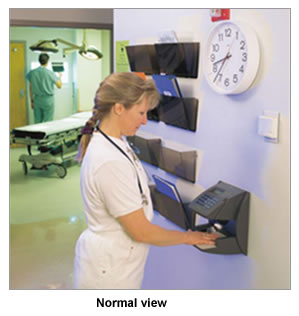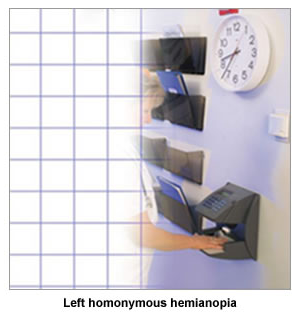Inattention
Inattention/hemi neglect occurs when stroke patients do not attend to the affected side of their space/body. This is most usually seen in non-dominant (right) hemisphere lesions and the head may be rotated and side flexed toward the unaffected side. The weak limbs of the affected side may cease to “belong” to the patient as they effectively disappear from the perceived body image. These limbs may be at considerable risk of physical trauma by wheelchairs, cot-sides and other such pieces of equipment. Patients may have great difficulty in turning to visualise anything appearing from the affected side including people trying to initiate conversation. This must be taken into account when assessing the extent of the perceptual deficit. Visuospatial inattention may exist in the presence of homonymous hemianopia, but the two may exist separately.
Homonymous hemianopia
This constitutes the loss of half of the visual field of each eye. The retinas on the same side as the lesion are affected and so the patient fails to see the image from the opposite side of the visual field. Thus, with a right hemisphere stroke the right half of each retina does not see, creating loss of vision to the left.


When associated with inattention also, the effect is a profound inability to see or perceive their affected side. This may be tested by asking the patient to look at your nose while you steady their head. You then bring an object such as a pen into the unaffected visual field from the periphery, asking the patient to indicate when they see it without looking directly at it. Repeat this process on the affected side and compare the position that the object was visualised in that field. This will allow you to establish whether a visual deficit exists.
Page last reviewed: 01 Feb 2021


